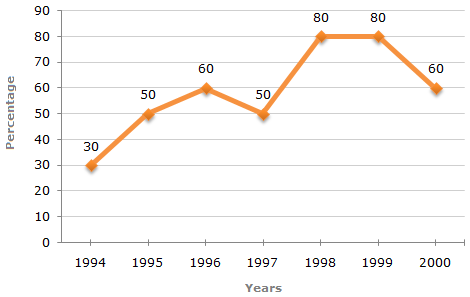The following line graph gives the percentage of the number of candidates who qualified an examination out of the total number of candidates who appeared for the examination over a period of seven years from 1994 to 2000. Percentage of Candidates Qualified to Appeared in an Examination Over the Years
A 20500
B
19000
C 24500
D
22000
Share : |
Directions to Solve In the following questions choose the word which is the exact OPPOSITE of the given words. A Dishonorable
B Reputed
C Paid
D Official
Share : |
A Addition, Subtraction, Multiplication, Division
B Addition, Division, Modulus, Subtraction
C Division, Multiplication, Addition, Subtraction
D Multiplication, Addition, Division, Subtraction
Share : |
A cell.
B word.
C byte.
D group.
Share : |
A Access time
B Break time
C Seek time
D Latency period
Share : |
A has all of the above characteristics
B has high storage capacity
C has in-system read and write capacity
D is nonvolatile
Share : |
A The data input
B The output enable
C The address input
D The chip enable
Share : |
A electrically erasable programmable read-only memory
B encapsulated electrical programmable read-only memory
C elementary electrical programmable read-only memory
D elementary erasable programmable read-only memory
Share : |
A SRAM
B secondary cache
C DRAM
D primary cache
Share : |
A First the data is set on the data bus and the address is set, then the write pulse stores the data.
B First the write pulse stores the data, then the address is set, and finally the data is set on the data bus.
C First the address is set, then the data is set on the data bus, and finally the read pulse stores the data.
D First the data is set on the data bus, then the write pulse stores the data, and finally the address is set.
Share : |






 Number of candidates qualified in 2000 = (33500 - 21200) = 12300.
Let the number of candidates appeared in 2000 be x.
Number of candidates qualified in 2000 = (33500 - 21200) = 12300.
Let the number of candidates appeared in 2000 be x.
 x =
x =
